Straw Bale Building as a Low-Tech Solution: A Case Study in Northern Poland
Abstract
:1. Introduction
2. Materials and Methods
- Heat transfer coefficient of external walls U-value;
- Analysis of condensation inside the envelope;
- Airtightness of the building.
2.1. Heat Transfer Coefficient of External Walls
- 1.9 cm timber cladding (not included in the U-value calculation).
- Ventilation void 4 cm (not included in U-value calculations).
- Clay plaster 1 cm.
- 4.5 × 15 cm and 4.5 × 8 cm double branch posts every 62 cm (between the axes), between straw bales 43 cm thick (along the wall). Across the wall, between the posts, there is a thermal insulation made of wood wool (λ = 0.038 W/mK).
- Clay plaster 3–4 cm.
- All layers of the wall are shown in Figure 4b.
- gSKIN KIT-2615C developed by greenTEG AG, Rümlang, Switzerland.
- (Heat flux sensor gSKIN-XO, logger DLOG-4231 with two temperature sensors),
- greenTEG logger software v1.02.09 developed by greenTEG AG, Rümlang, Switzerland.
2.2. Analysis of Condensation Inside the Envelope
2.3. Building Airtightness Tests
- Sealing of electrical sockets;
- Eliminating cracks in the interior plaster by deepening and widening the crack and then filling in with clay;
- Completing the final coat of plaster in the living room;
- Completing the loss of external plaster.
3. Results
3.1. Testing the Thermal Conductivity Coefficient U-Value
- Measurement duration min. 72 h (+ total multiple of 24). The greenTEC software automatically calculates the relevant time frame.
- The U-value obtained at the end of the test does not deviate by more than 5% from the value obtained during the first 24 h.
- The U-value obtained during the first 2/3 of the entire measurement period does not deviate by more than 5% from the values obtained during the last 2/3 of the entire measurement period.
- The change in the heat stored in the wall is ≤ 5% of the heat passing through the wall.
- The measurement meeting the above requirements took place on 13 February 2021 (measurements from 12:42 on 08 February 2021 to 12:42 on 13 February 2021). The partial U-values were 0.18 W/(m2K) and 0.19 W/(m2K). The calculated U-value is 0.19 W/(m2K). The results are shown in Figure 16 and Figure 17.
3.2. Analysis of Condensation Inside the Envelope
3.3. Airtightness of the Building
4. Discussion
5. Conclusions
Funding
Institutional Review Board Statement
Informed Consent Statement
Data Availability Statement
Conflicts of Interest
References
- Pritchard, M.B.; Pitts, A. Evaluation of strawbale building: Benefits and risks. Archit. Sci. Rev. 2006, 49, 372–384. [Google Scholar] [CrossRef]
- Jacques, S.L. Strawbale Construction. In Design for Sustainability: A Sourcebook of Integrated Ecological Solutions; Birkeland, J., Ed.; Taylor & Francis Group: London, UK, 2002; pp. 197–199. [Google Scholar] [CrossRef]
- Tlaiji, G.; Ouldboukhitine, S.; Pennec, F.; Biwole, P. Thermal and mechanical behavior of straw-based construction: A review. Constr. Build. Mater. 2022, 316, 125915. [Google Scholar] [CrossRef]
- European Straw Building Association ESBA and UP STRAW Achievements. Available online: https://strawbuilding.eu/ (accessed on 21 September 2022).
- FASBA—Fachverband Strohballenbau Deutschland e.V. Available online: https://fasba.de/ (accessed on 1 December 2022).
- RFCP—Le Réseau Français de la Construction Paille. Available online: https://www.rfcp.fr/ (accessed on 1 December 2022).
- ASBN—Austrian Strawbale Network. Available online: https://baubiologie.at/strohballenbau/) (accessed on 1 December 2022).
- Ogólnopolskie Stowarzyszenie Budownictwa Naturalnego. Available online: http://www.osbn.pl (accessed on 1 December 2022).
- Zatylny, M. Uwarunkowania Formalno-Prawne dla Budownictwa Naturalnego w Europie i Polsce ze Szczególnym Uwzględnieniem Zastosowania Kostek Słomy; Program Narodów Zjednoczonych ds. Rozwoju (UNDP): Warszawa, Poland, 2014. [Google Scholar]
- Lehner, P.; Horňáková, M.; Vlček, P.; Teslík, J. Experimental investigation of two test setups on straw bales used as load-bearing elements of buildings. Buildings 2021, 11, 539. [Google Scholar] [CrossRef]
- Ashour, T.; Wu, W. Using of barley straw as building material. In Barley: Production, Cultivation and Uses; Elfson, S.B., Ed.; Nova Science Publishers, Inc.: Hauppauge, NY, USA, 2011; pp. 273–300. [Google Scholar]
- Pierzchalski, M. Architektoniczna Optymalizacja Budynków Mieszkalnych Jednorodzinnych w Zakresie Oddziaływania na Środowisko Naturalne Przy Wykorzystaniu Oceny Cyklu Życia (LCA). Ph.D. Thesis, Politechnika Warszawska, Warsaw, Poland, 2019. [Google Scholar]
- Goodhew, S.; Griffiths, R. Sustainable earth walls to meet the building regulations. Energy Build. 2005, 37, 451–459. [Google Scholar] [CrossRef]
- Shea, A.; Wall, K.; Walker, P. Evaluation of the thermal performance of an innovative prefabricated natural plant fibre building system. Build. Serv. Eng. Res. Technol. 2013, 34, 369–380. [Google Scholar] [CrossRef] [Green Version]
- Munch-Andersen, J.; Andersen, B.M. Straw Bale Houses—Design and Material Properties, Danish Building and Urban Research. Available online: http://www.baubiologie.at/download/jma_slides_halmhuse.pdf (accessed on 1 December 2022).
- Costes, J.-P.; Evrard, A.; Biot, B.; Keutgen, G.; Daras, A.; Dubois, S.; Lebeau, F.; Courard, L. Thermal conductivity of straw bales: Full size measurements considering the direction of the heat flow. Buildings 2017, 7, 11. [Google Scholar] [CrossRef] [Green Version]
- D’Alessandro, F.; Bianchi, F.; Baldinelli, G.; Rotili, A.; Schiavoni, S. Straw bale constructions: Laboratory, in field and numerical assessment of energy and environmental performance. J. Build. Eng. 2017, 11, 56–68. [Google Scholar] [CrossRef]
- Douzane, O.; Promis, G.; Roucoult, J.M.; Le, A.D.T.; Langlet, T. Hygrothermal performance of a straw bale building: In situ and laboratory investigations. J. Build. Eng. 2016, 8, 91–98. [Google Scholar] [CrossRef]
- Bau EPD GmbH. EPD—Environmental Product Declaration; EPD-FASBA-2014-1-ECOINVENT; Baustroh Fachverband Strohballenbau Deutschland (FASBA) e.V.: Verden, Germany, 2014. [Google Scholar]
- Janowska-Renkas, E.; Król, A.; Pochwała, S.; Pałubski, D.; Adamska, M.; Klementowski, I. The Fire Resistance and Heat Conductivity of Natural Construction Material Based on Straw and Numerical Simulation of Building Energy Demand. Energies 2022, 15, 1155. [Google Scholar] [CrossRef]
- Minke, G.; Krick, B. Straw Bale Construction Manual: Design and Technology of a Sustainable Architecture; Birkhäuser Verlag GmbH: Basel, Switzerland, 2020. [Google Scholar]
- Chaussinand, A.; Scartezzini, J.L.; Nik, V. Straw bale: A waste from agriculture, a new construction material for sustainable buildings. Energy Procedia 2015, 78, 297–302. [Google Scholar] [CrossRef]
- Lal, R. Sequestering carbon in soils of agro-ecosystems. Food Policy 2011, 36 (Suppl. S1), S33–S39. [Google Scholar] [CrossRef]
- Building Research Institute (ITB). Badanie Współczynnika Przewodzenia Ciepła Kostek Słomy; Nr pracy: 02236/15/Z00NG (LFS00-02236/15/Z00NF); Building Research Institute: Warsaw, Poland, 2015. [Google Scholar]
- Minke, G.; Krick, B. Podręcznik Budowania z Kostek Słomy, Podstawy, Konstrukcje, Przykłady; Fundacja Cohabitat: Łódź, Poland, 2015. [Google Scholar]
- Krick, B. Untersuchung von Strohballen und Strohballenkonstruktionen Hinsichtlich Ihrer Anwendung für ein Energiesparendes Bauen Unter Besonderer Berücksichtigung der Lasttragenden Bauweise; Kassel University Press GmbH: Kassel, Germany, 2008; Available online: http://www.uni-kassel.de/upress/online/frei/978-3-89958-422-6.volltext.frei.pdf (accessed on 1 December 2022).
- González, A.D. Energy and carbon embodied in straw and clay wall blocks produced locally in the Andean Patagonia. Energy Build. 2014, 70, 15–22. [Google Scholar] [CrossRef]
- Latif, E.; Ciupala, M.A.; Tucker, S.; Wijeyesekera, D.C.; Newport, D.J. Hygrothermal performance of wood-hemp insulation in timber frame wall panels with and without a vapour barrier. Build. Environ. 2015, 92, 122–134. [Google Scholar] [CrossRef] [Green Version]
- Pihelo, P.; Kikkas, H.; Kalamees, T. Hygrothermal Performance of Highly Insulated Timber-frame External Wall. Energy Procedia 2016, 96, 685–695. [Google Scholar] [CrossRef] [Green Version]
- Straube, J. BSD-112: Building Science for Strawbale Buildings. Building Science Corporation, 30 January 2009. Available online: https://www.buildingscience.com/documents/digests/bsd-112-building-science-for-strawbale-buildings (accessed on 5 November 2022).
- Marques, B.; Tadeu, A.; Almeida, J.; António, J.; de Brito, J. Characterisation of sustainable building walls made from rice straw bales. J. Build. Eng. 2020, 28, 101041. [Google Scholar] [CrossRef]
- Bennett, J.; Butler, J.; Jones, B.; Sutherland, E. Straw Construction in the UK; Technical Guide First Edition; School of Natural Building: Todmorden West Yorkshire, UK, 2022. [Google Scholar]
- Langmans, J.; Versele, A.; Roels, S. On the Hygrothermal Performance of Straw Bale Wall Elements in Belgium. 2014. Available online: http://nimbusvault.net/publications/koala/sebra (accessed on 1 December 2022).
- Robinson, J.; Aoun, H.K.; Davison, M. Determining Moisture Levels in Straw Bale Construction. Procedia Eng. 2017, 171, 1526–1534. [Google Scholar] [CrossRef]
- Bronsema, N.R. Moisture Movement and Mould Management in Straw Bale Walls for a Cold Climate; University of Waterloo: Waterloo, Belgium, 2010. [Google Scholar]
- Ashour, T.; Georg, H.; Wu, W. Performance of straw bale wall: A case of study. Energy Build. 2011, 43, 1960–1967. [Google Scholar] [CrossRef]
- Eurostat. Heating and Cooling Degree Days—Statistics. May 2022. Available online: https://ec.europa.eu/eurostat/statistics-explained/index.php?title=Heating_and_cooling_degree_days_-_statistics (accessed on 21 November 2022).
- Fromme, I.; Herz, U. Lehm- und Kalkputze: Mörtel Herstellen, Wände Verputzen, Oberflächen Gestalten; Öekobuch Verlag GmbH: Rastede, Germany, 2012. [Google Scholar]
- Lets Control It—ESPEasy. Available online: https://www.letscontrolit.com/wiki/index.php?title=Main_Page (accessed on 12 September 2022).
- Prus, S. Raport z Kontroli Termowizyjnej Nr 10/12/2020/TR 001; Prusdis: Sędziszów, Poland, 2020. [Google Scholar]
- Prus, S. Raport Badania Szczelności Powietrznej Obudowy Budynku; Prusdis: Sędziszów, Poland, 2020. [Google Scholar]
- O’Hegarty, R.; Kinnane, O.; Lennon, D.; Colclough, S. In-situ U-value monitoring of highly insulated building envelopes: Review and experimental investigation. Energy Build. 2021, 252, 111447. [Google Scholar] [CrossRef]
- Gaspar, K.; Casals, M.; Gangolells, M. In situ measurement of façades with a low U-value: Avoiding deviations. Energy Build. 2018, 170, 61–73. [Google Scholar] [CrossRef]
- Atsonios, I.A.; Mandilaras, I.D.; Kontogeorgos, D.A.; Founti, M.A. Two new methods for the in-situ measurement of the overall thermal transmittance of cold frame lightweight steel-framed walls. Energy Build. 2018, 170, 183–194. [Google Scholar] [CrossRef]
- Brojan, L.; Weil, B.; Clouston, P.L. Air Tightness of Straw Bale Construction. J. Green Build. 2015, 10, 99–113. [Google Scholar] [CrossRef]
- Racusin, J.D.; Graham, B.; McArleton, A. Final Report for Energy Performance of Straw Bale Buildings Research Program; Montgomery Publishing: Montgomery, AL, USA, 2011. [Google Scholar]
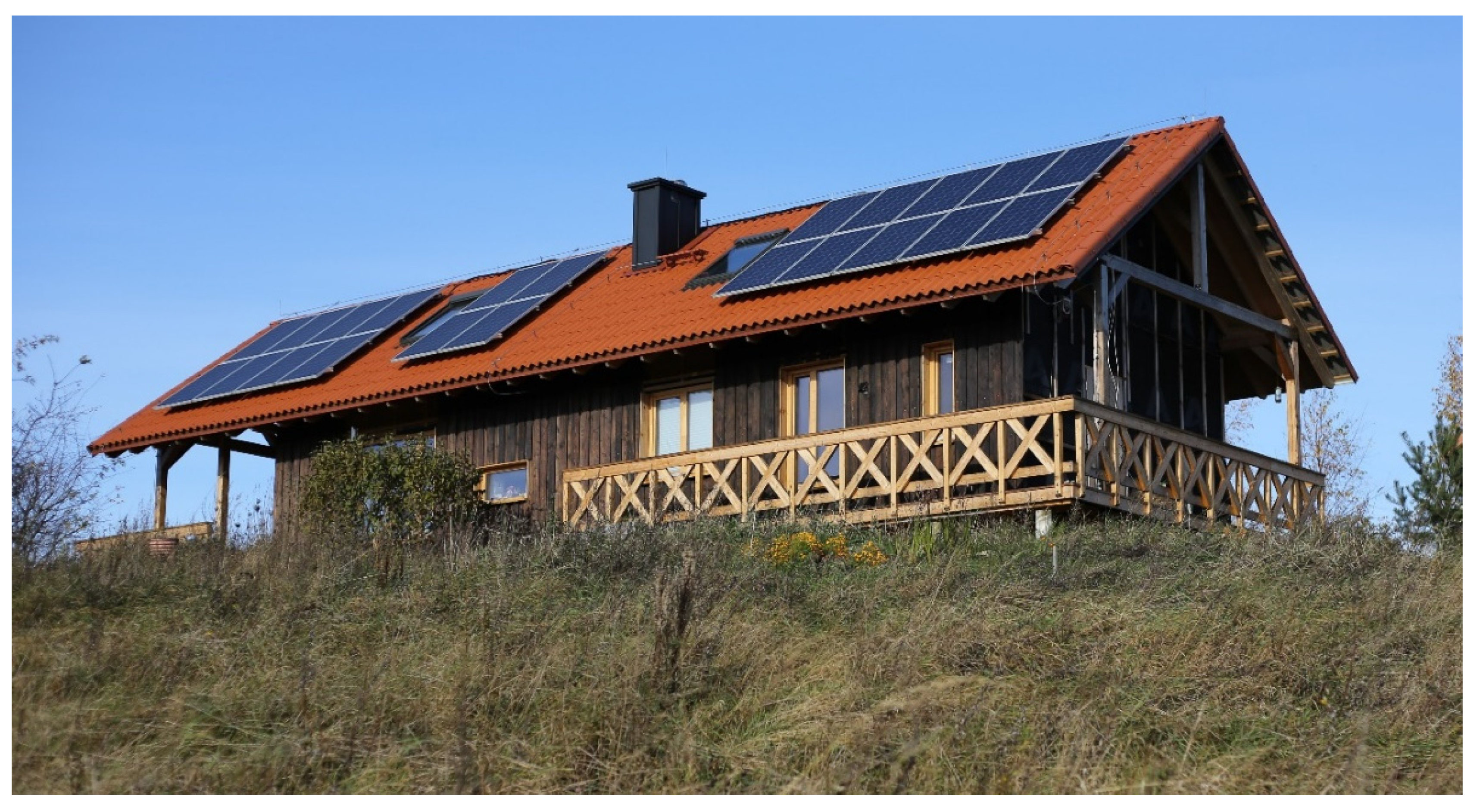

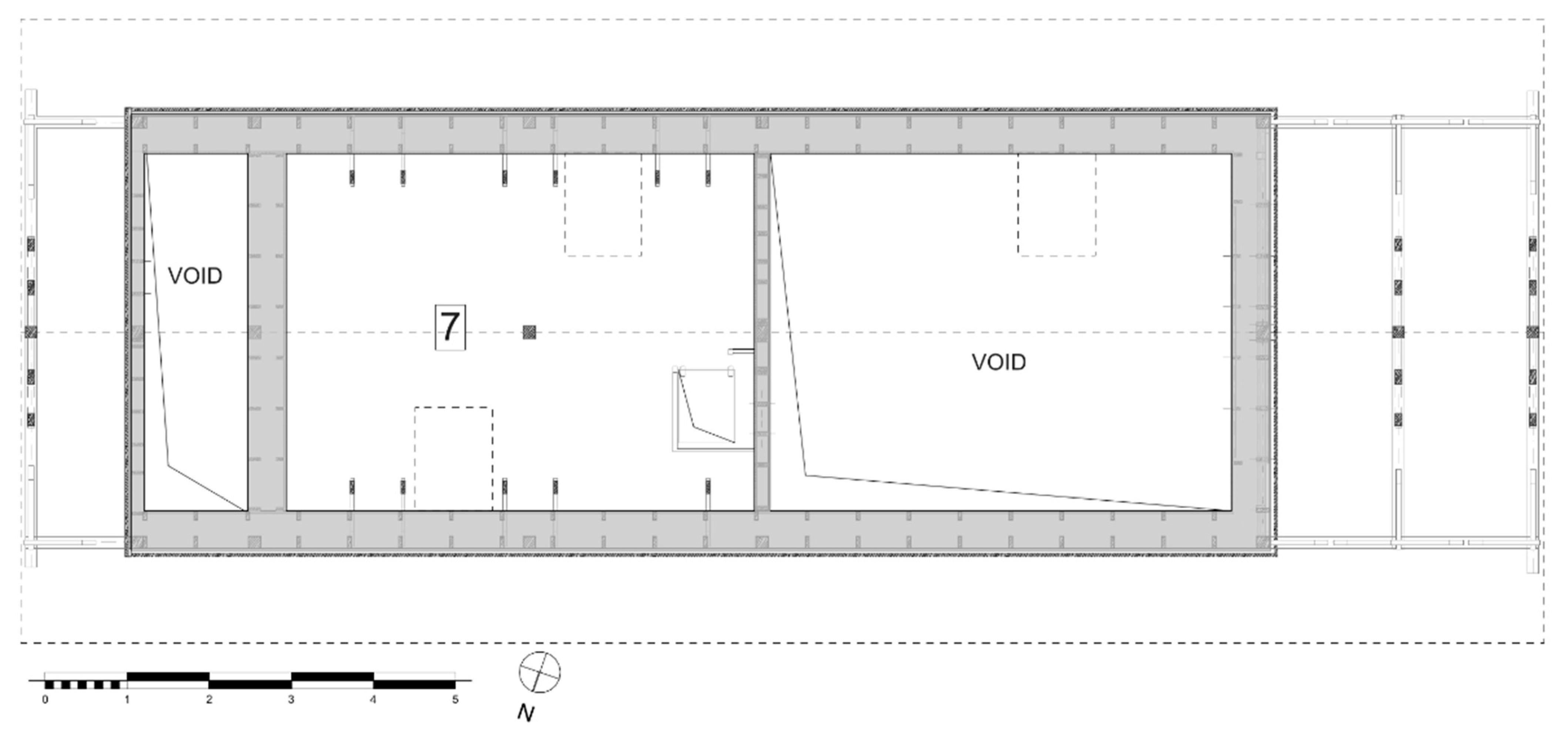
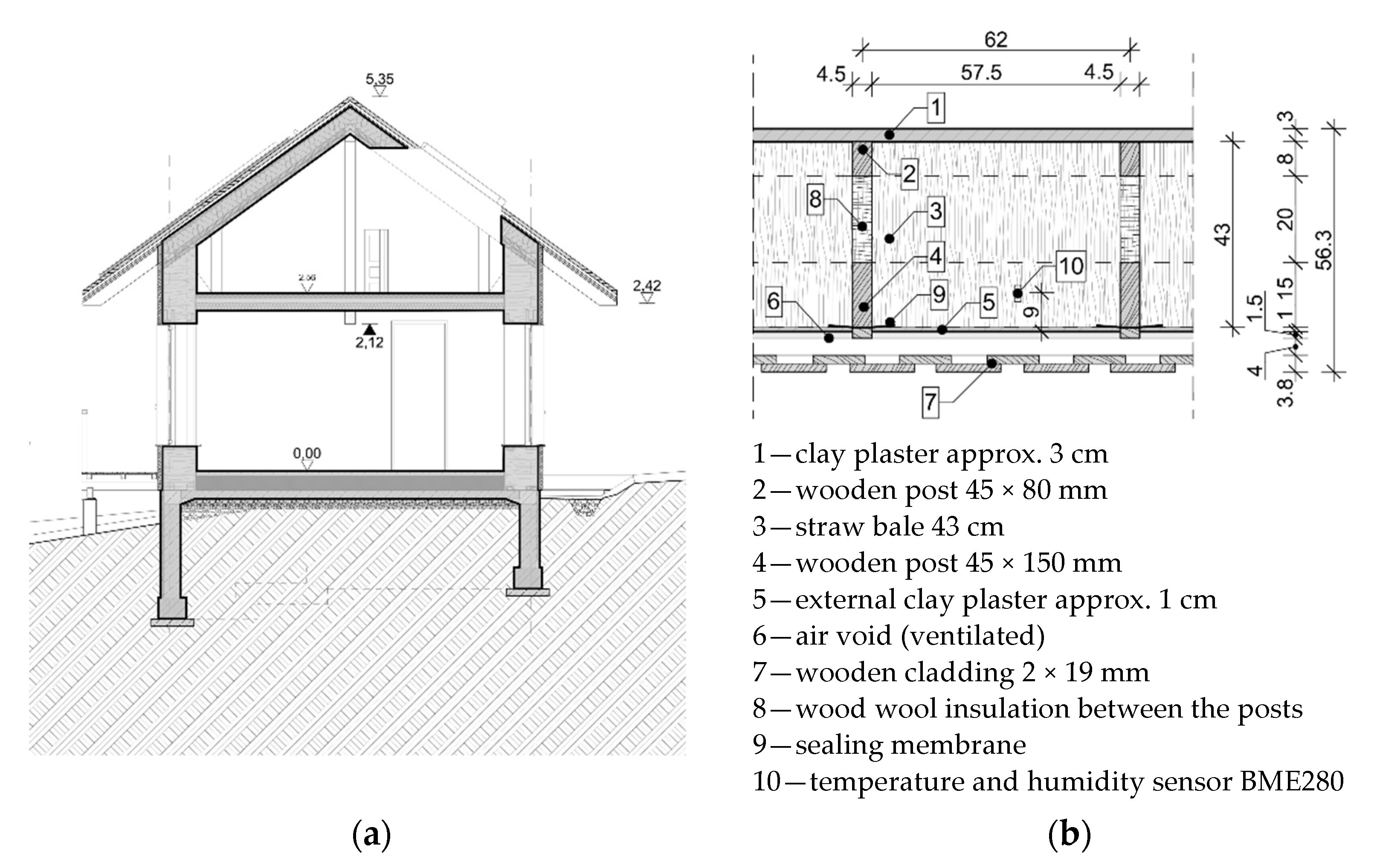
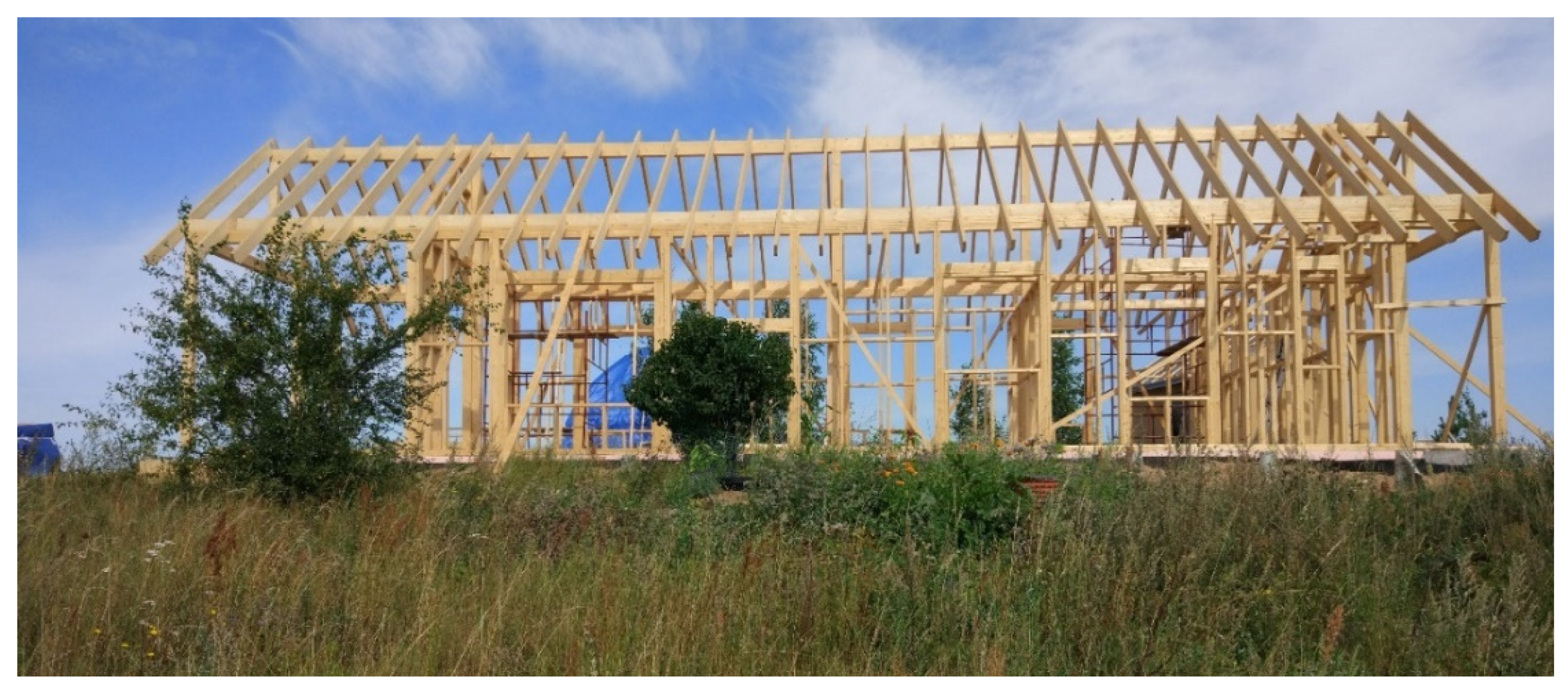
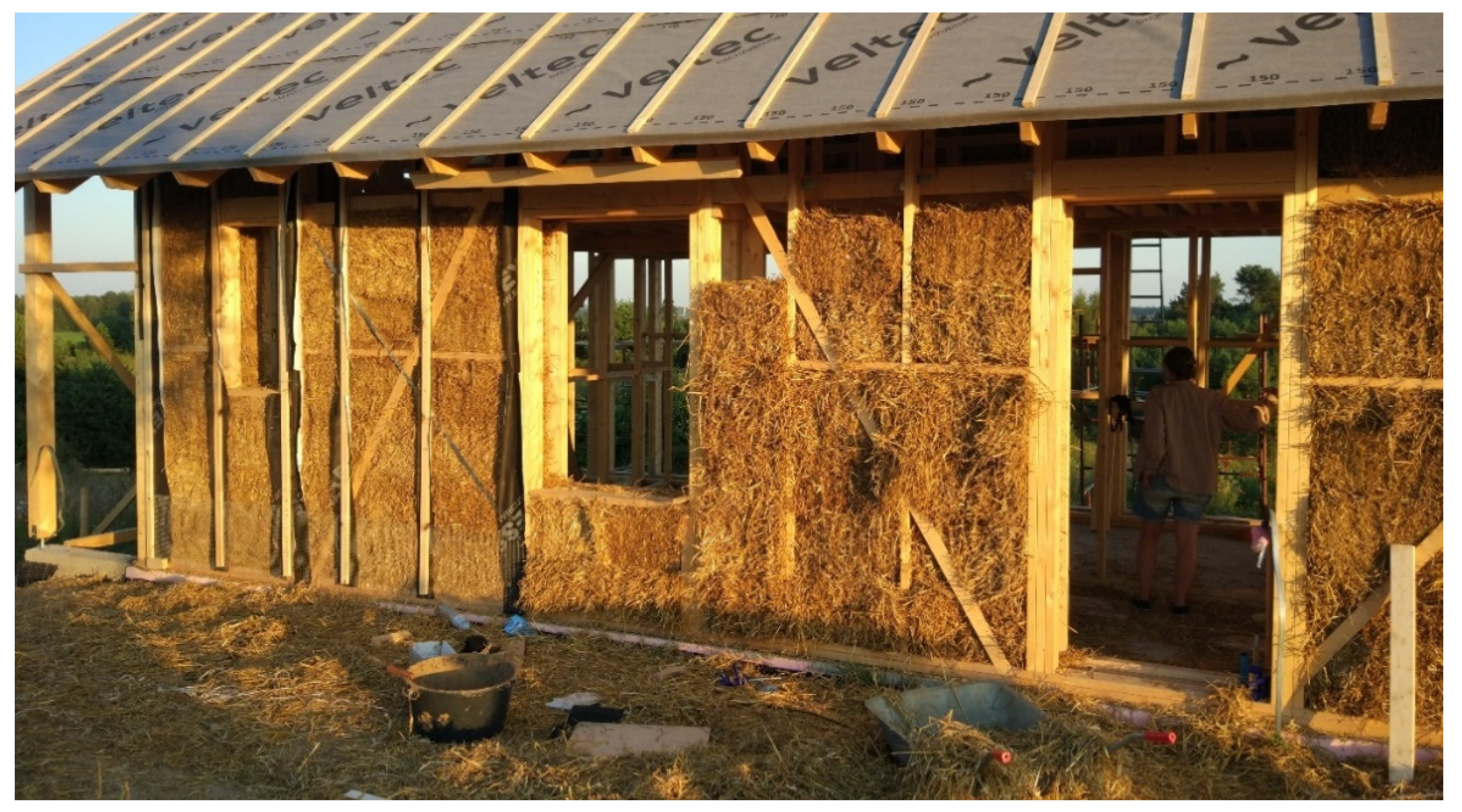
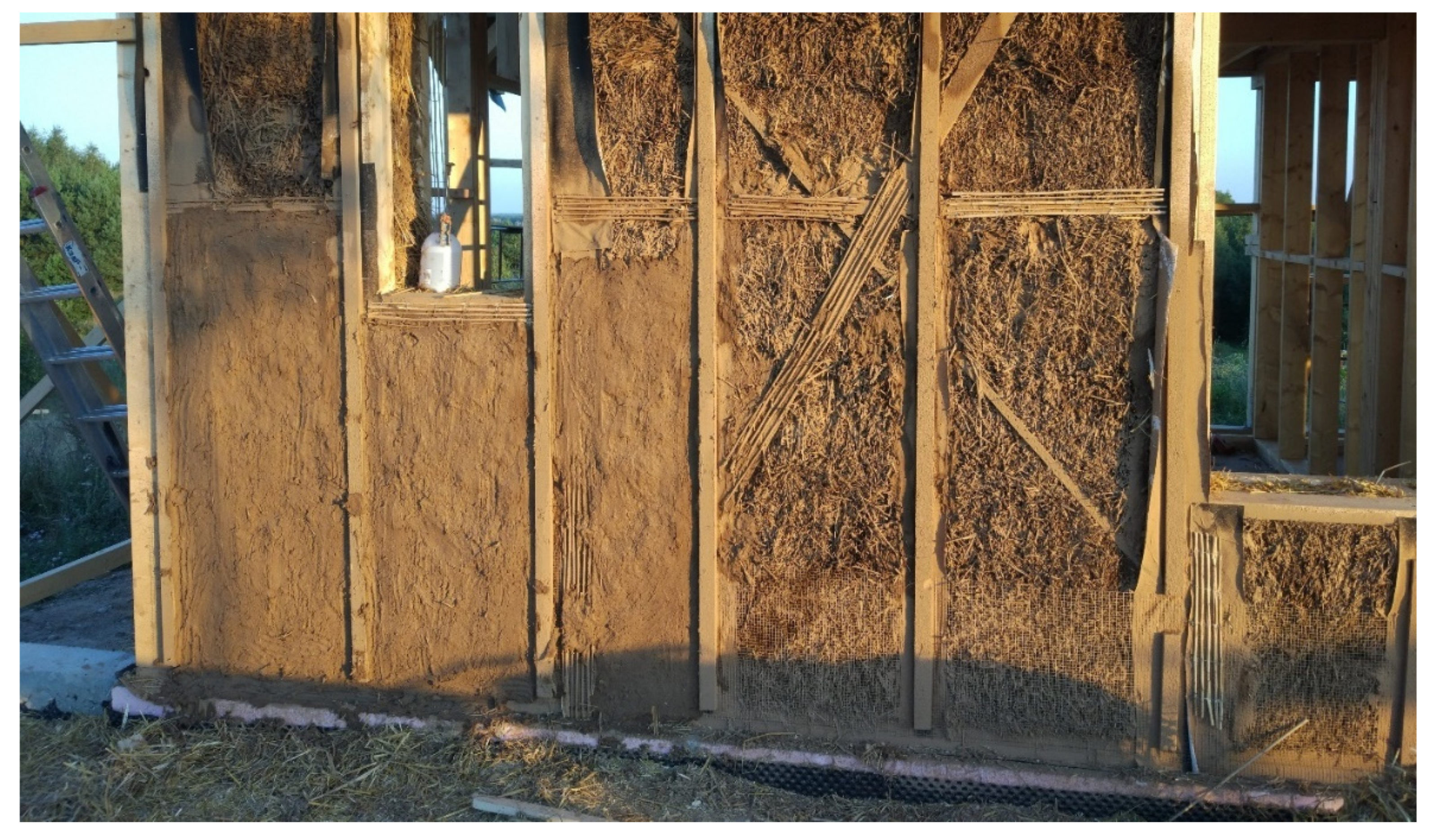
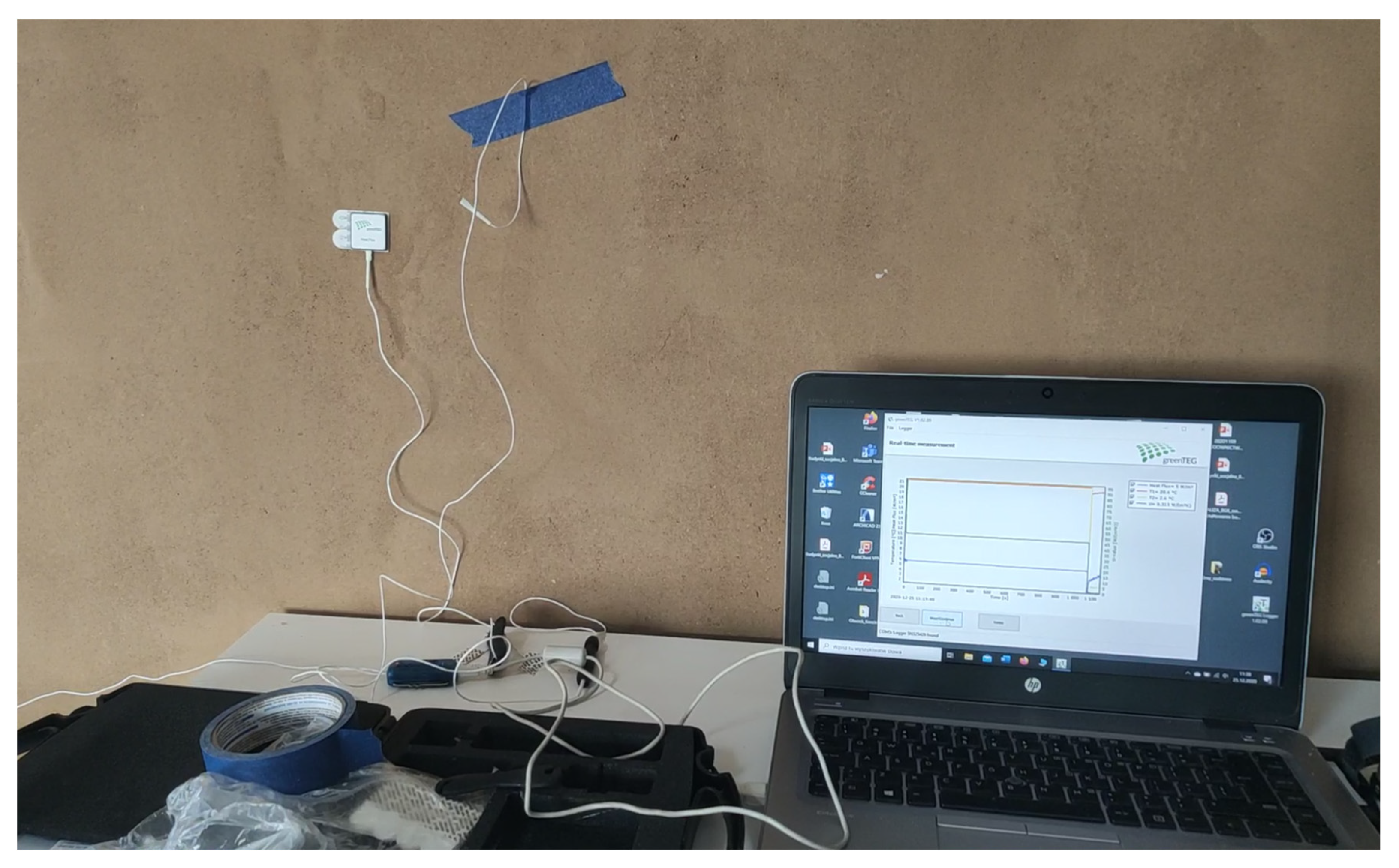
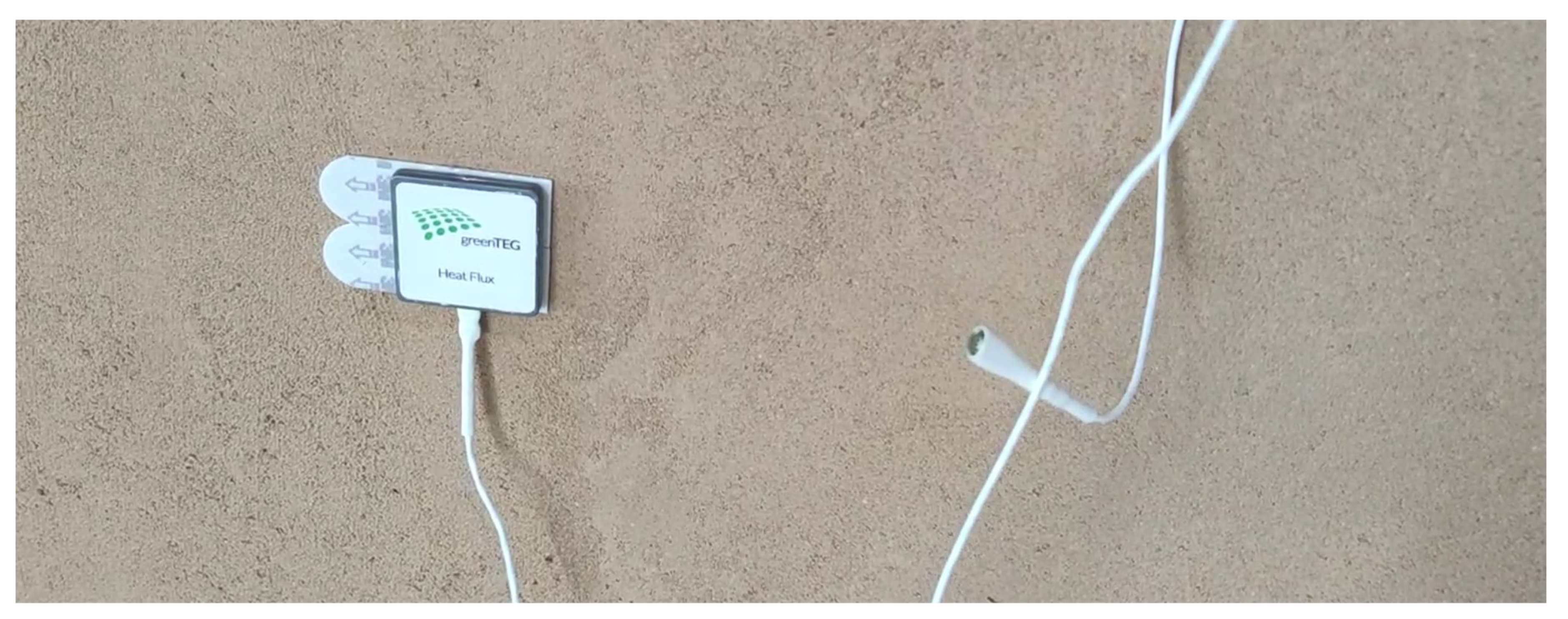
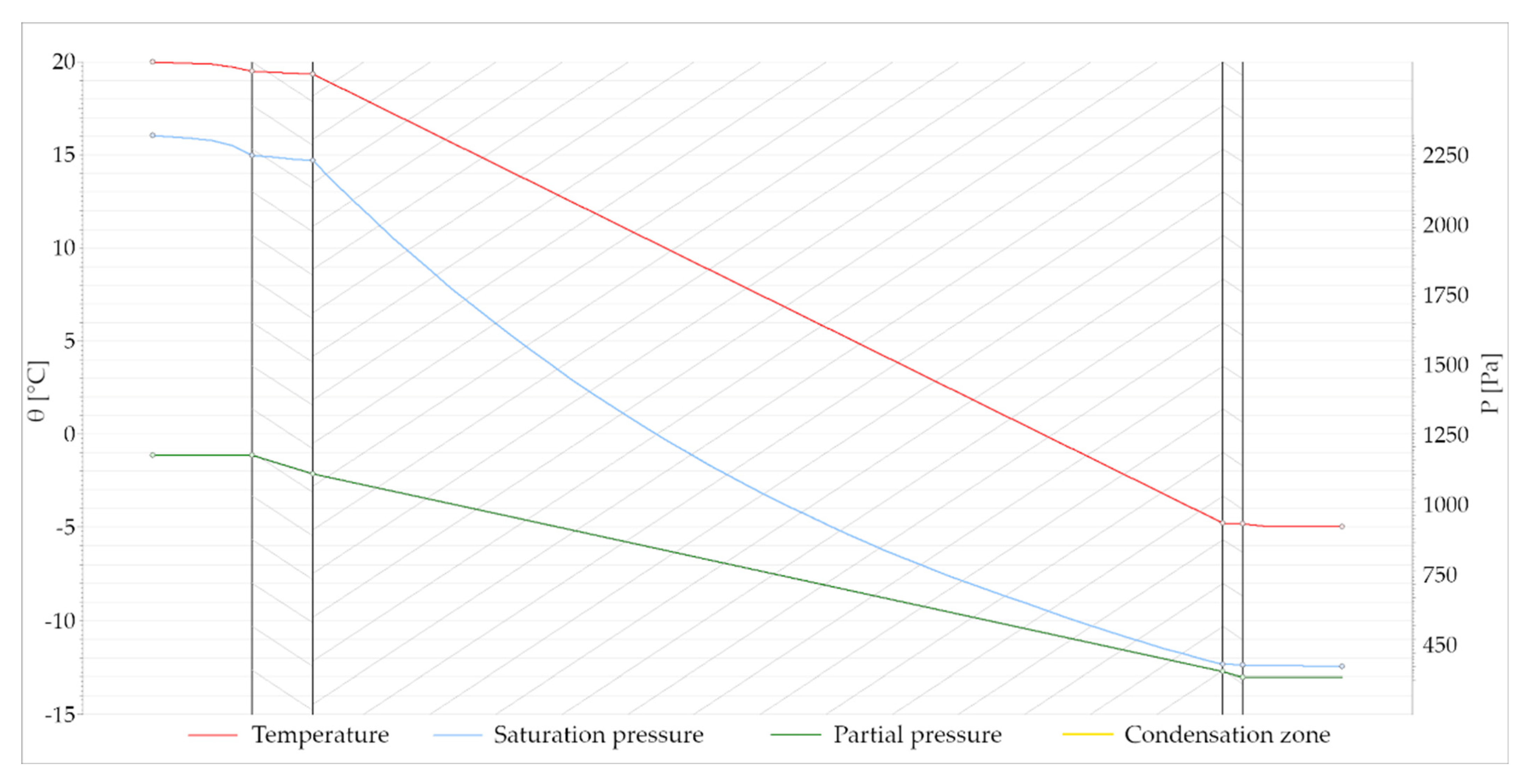
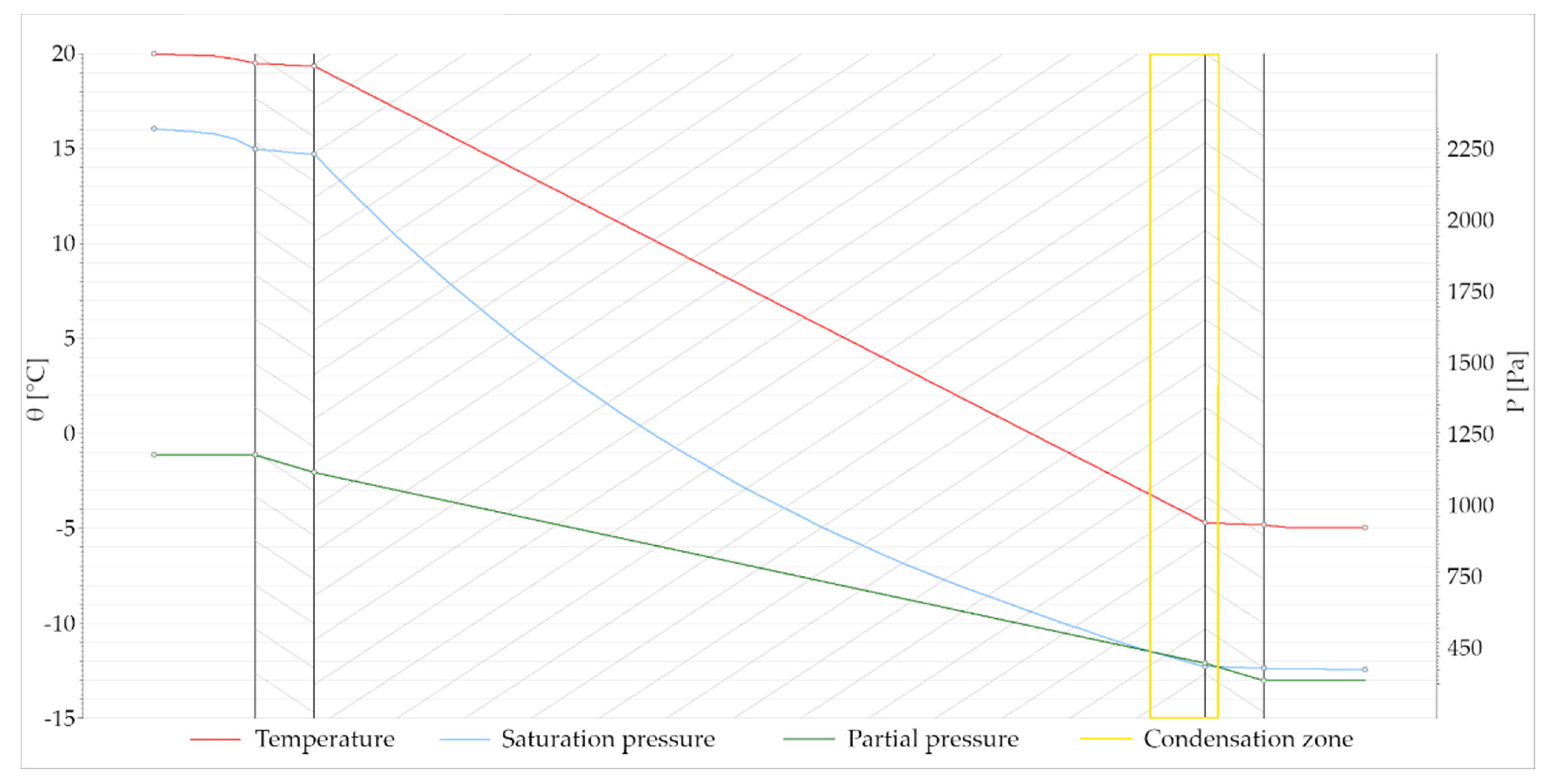
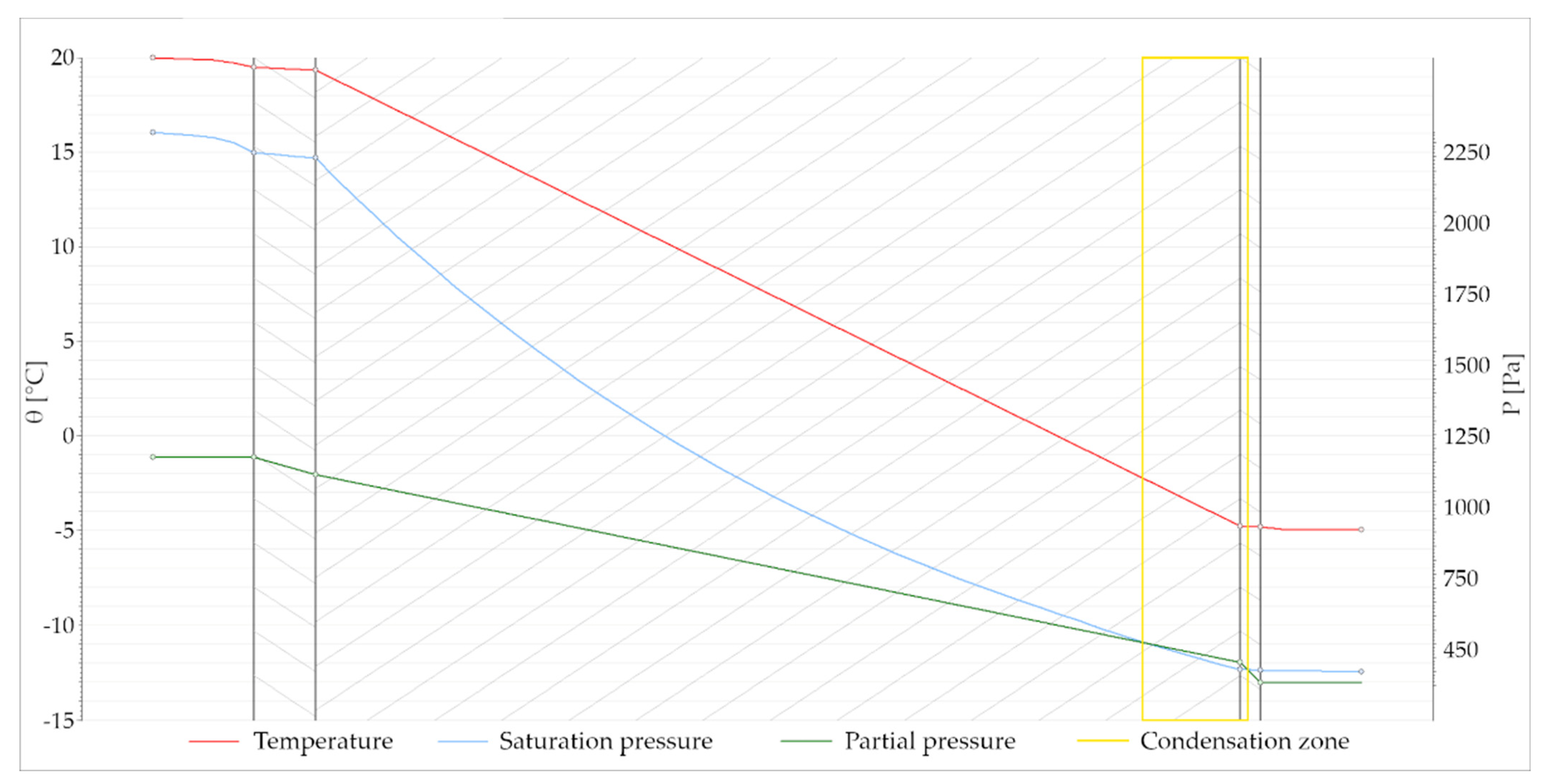
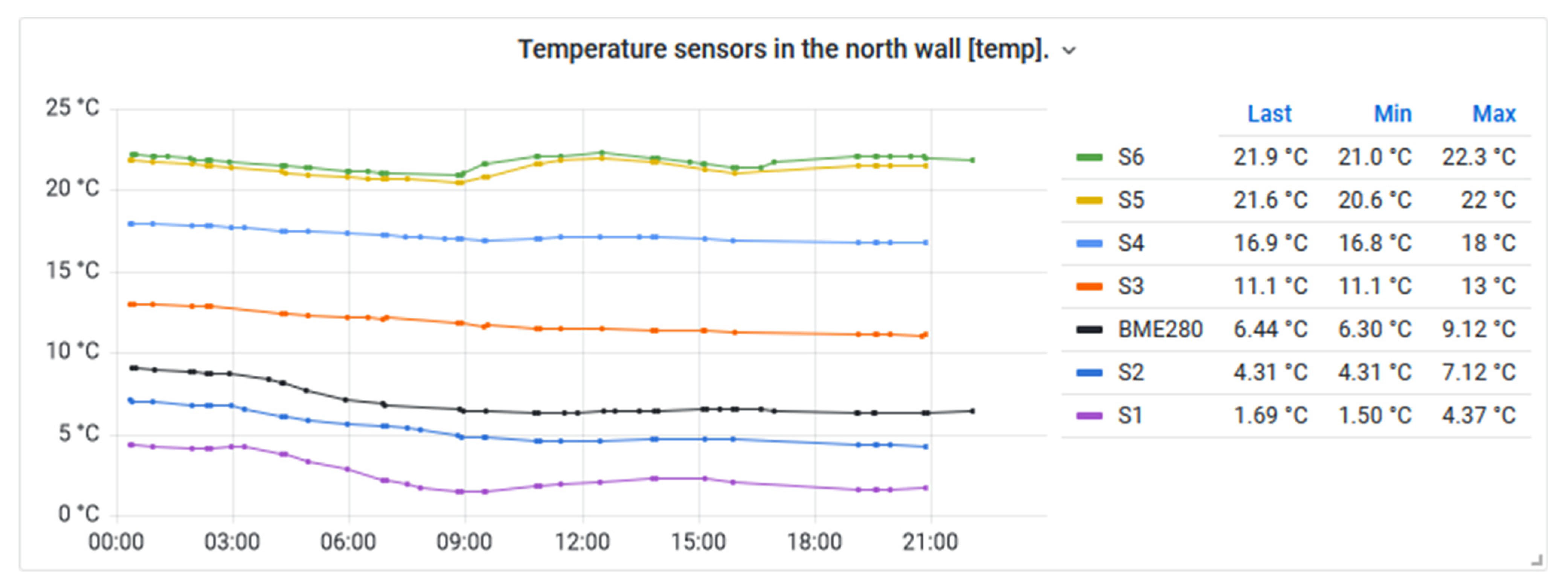
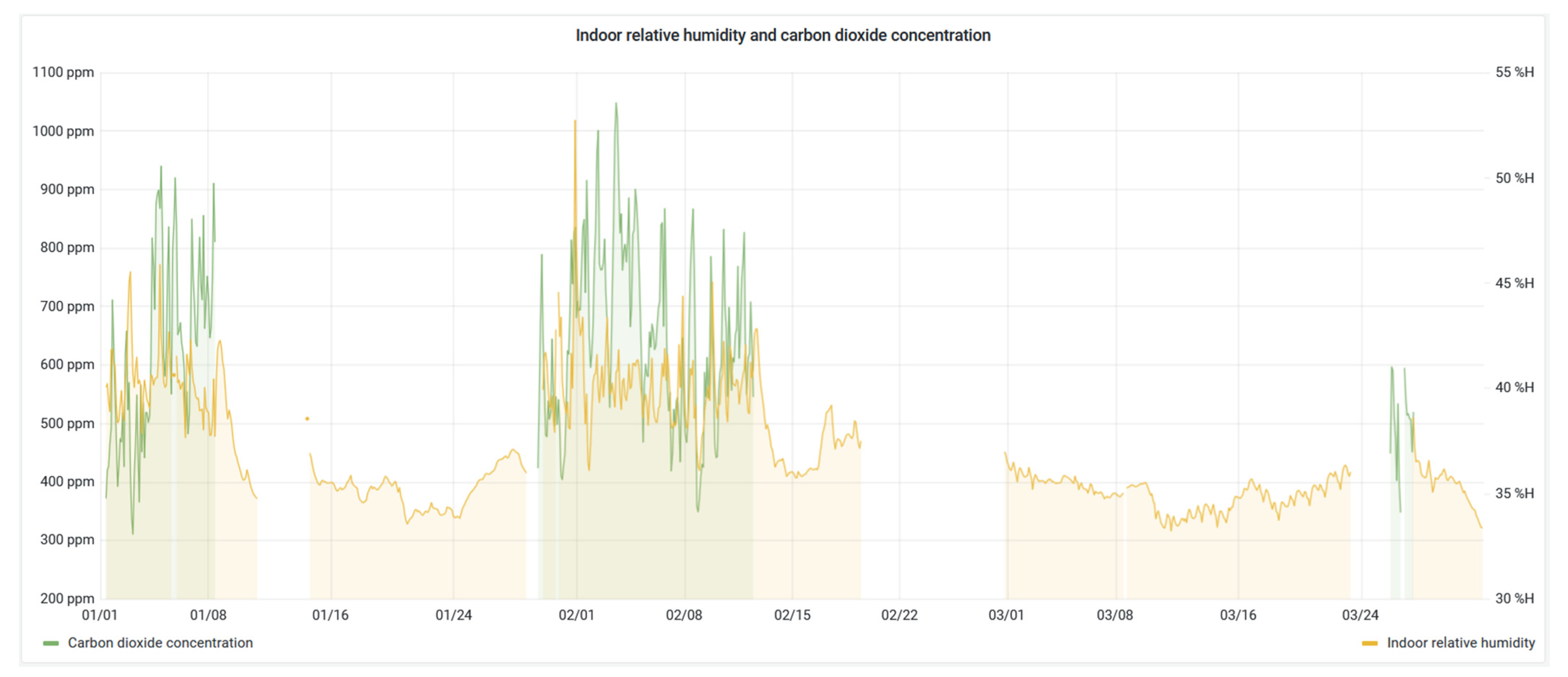
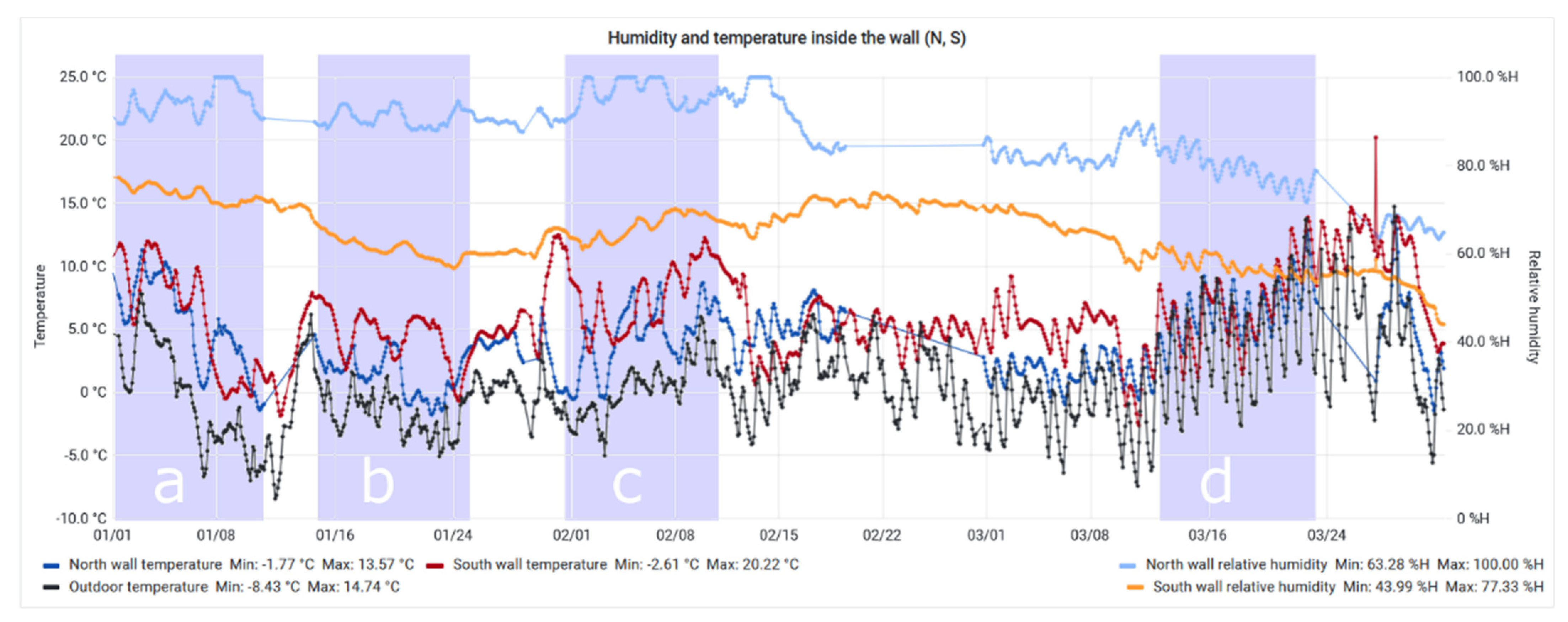
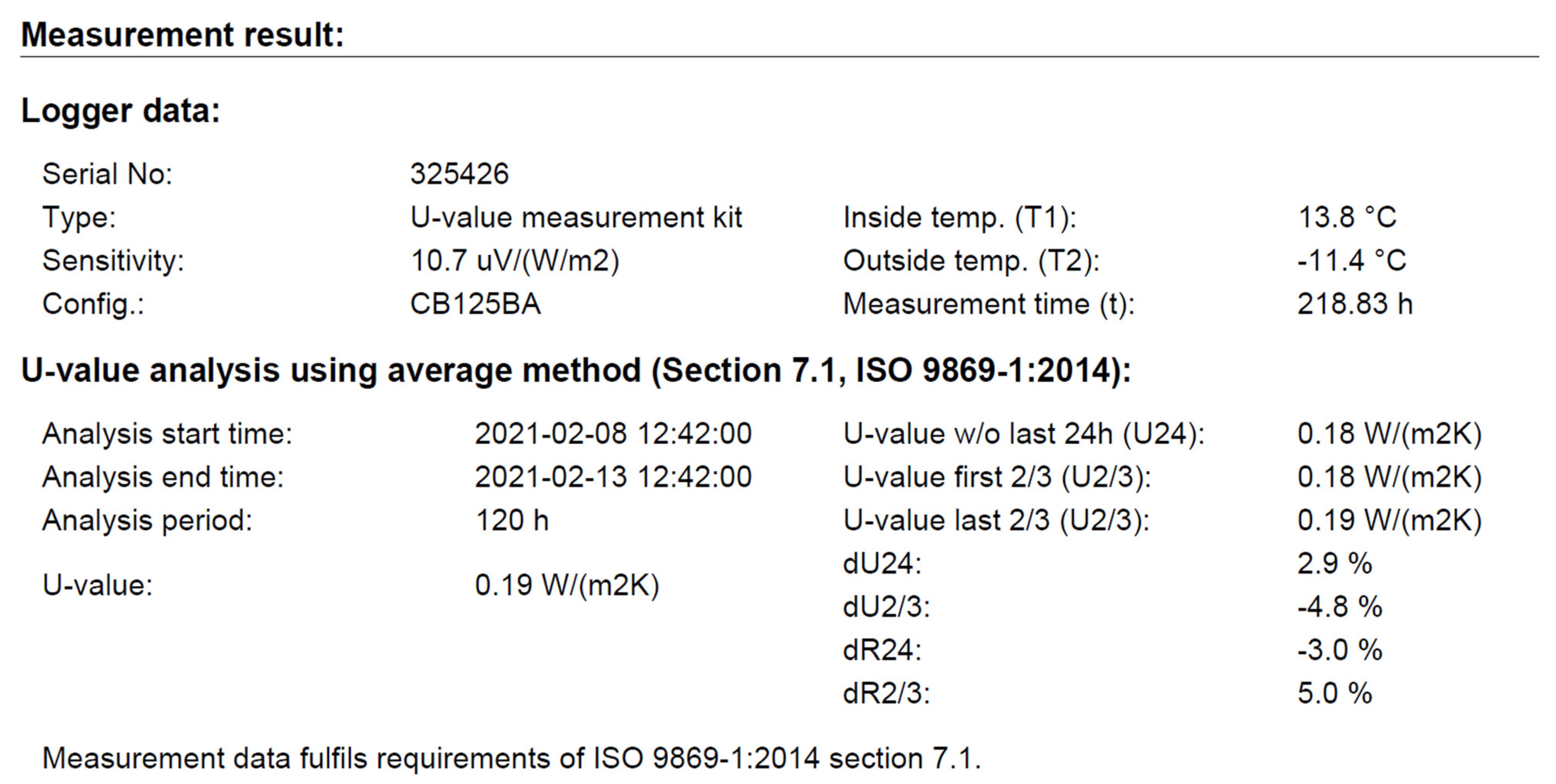
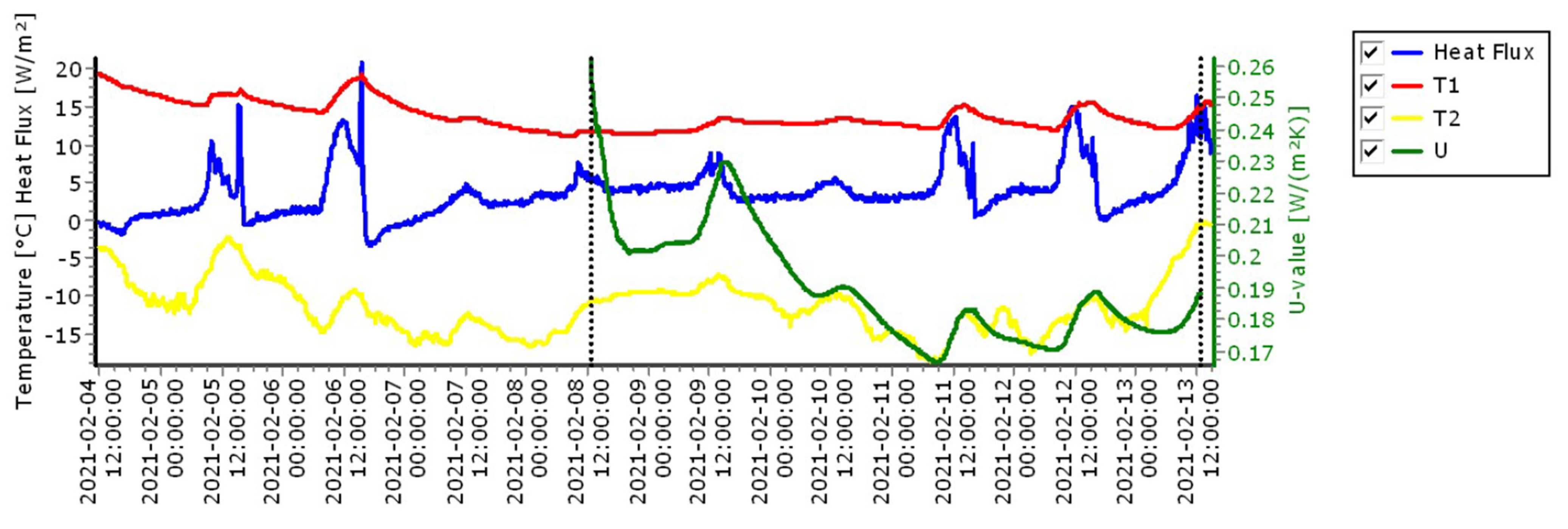
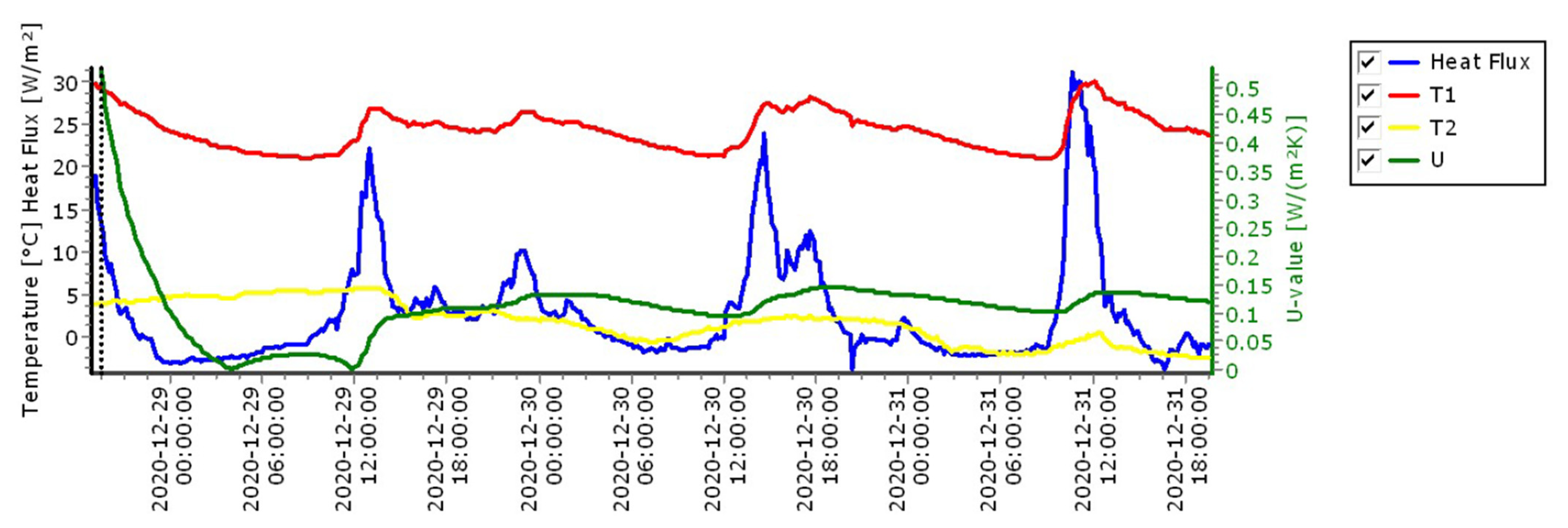
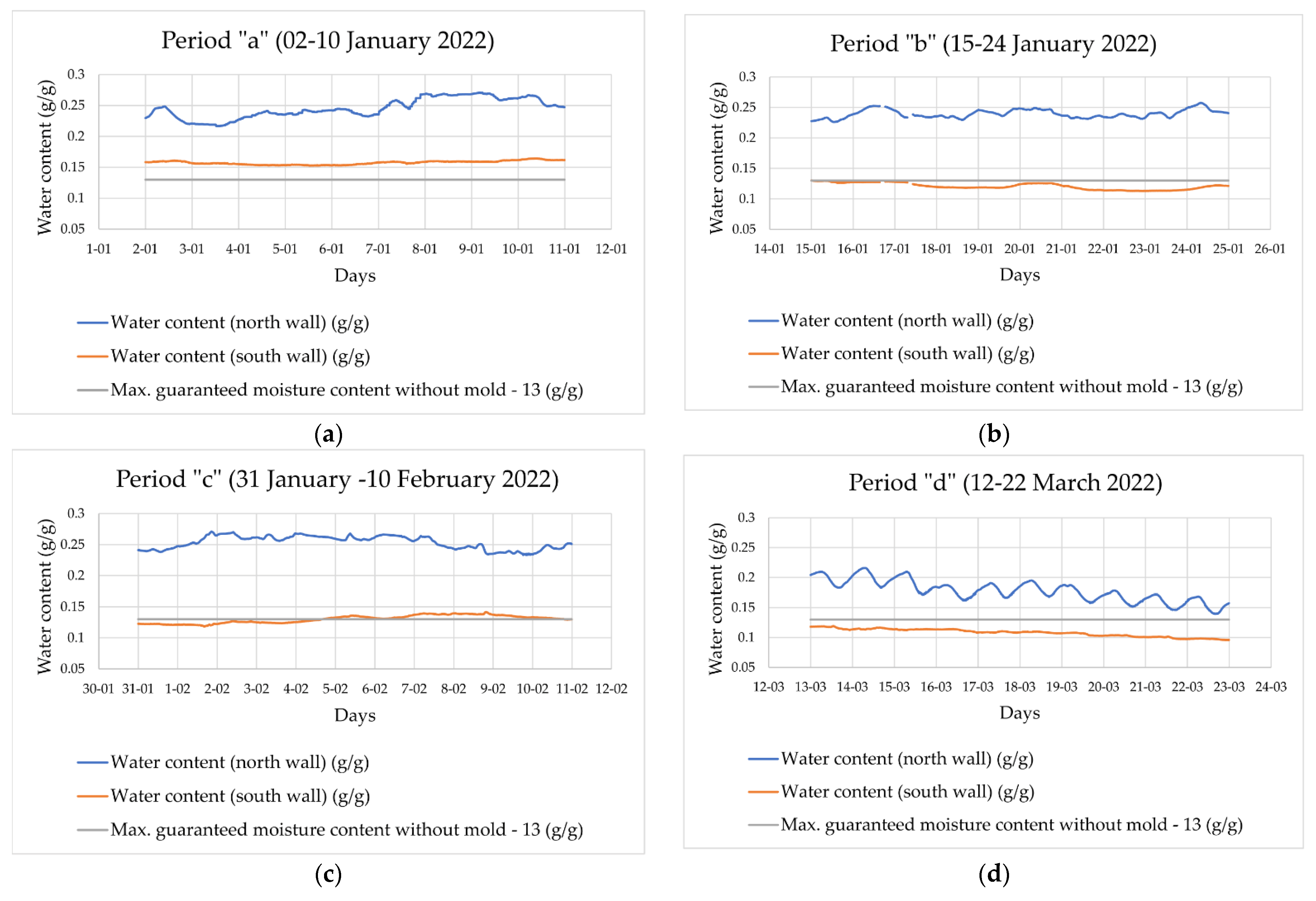
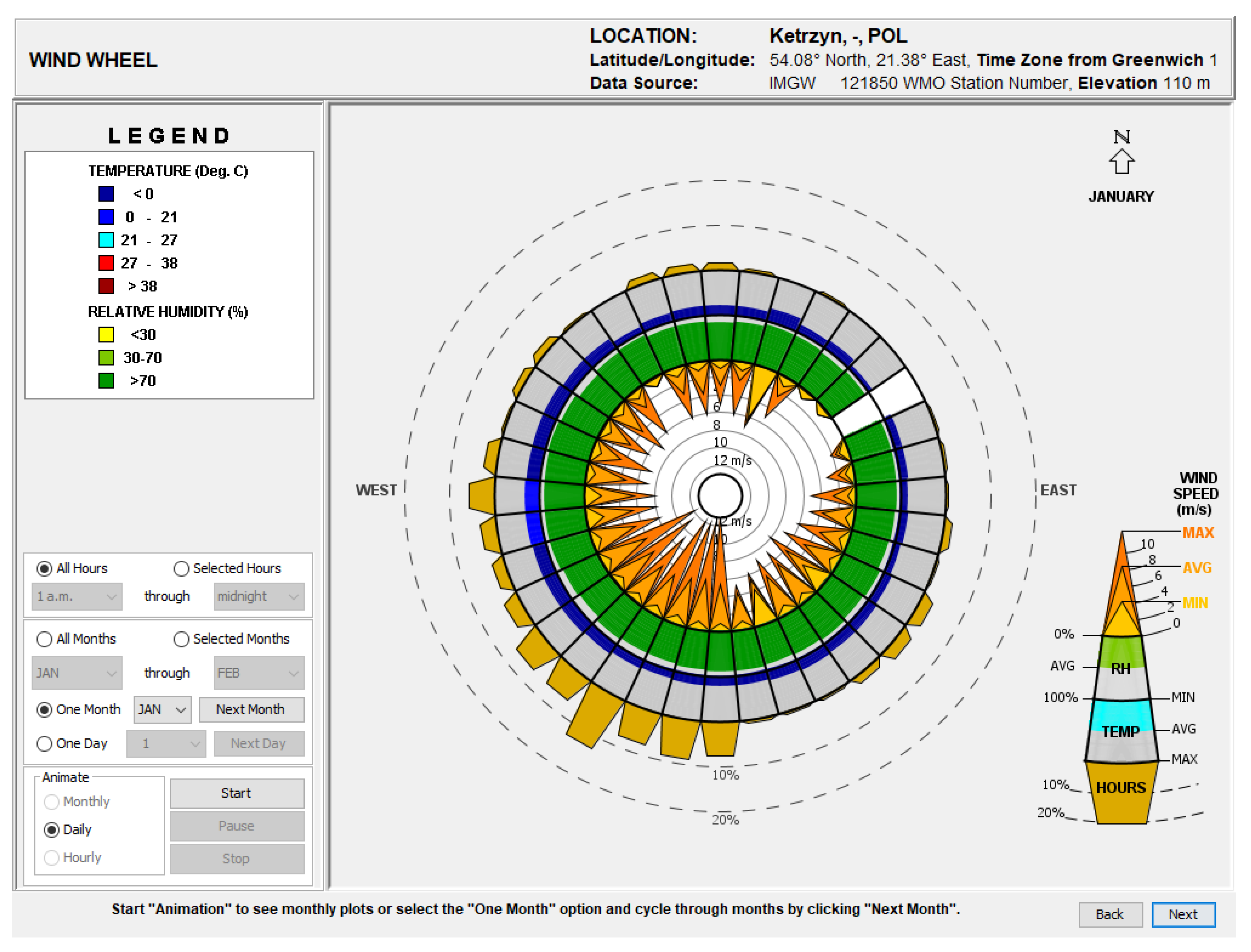
| Volumetric Mass Density (kg/m3) | Thermal Conductivity Coefficient λ (W/mK) | Data Source | |
|---|---|---|---|
| Parallel Position of Steams | Perpendicular Position of Steams | ||
| 60 | 0.067 | 0.067 | [13] |
| 63 | 0.059 | - | [14] |
| 75 | 0.056 | 0.052 | [15] from [16] |
| 75 | 0.057 | 0.052 | [15,17] |
| 80 | 0.072 (λ10 dry) | 0.051 (λ10 dry) | [18] |
| 80 | 0.067 (λ0) | 0.046 (λ0) | [18] |
| 62/81 | 0.082 | 0.057 | [15] |
| 87.4 | 0.062 | - | [14] |
| - | 0.061 | 0.048 | [18] |
| 90 | 0.060 | 0.056 | [15,17] |
| 85–115 (nominal 100) | - | 0.044 (λ10 dry)/0.052 | [19] |
| 100 | - | 0.038 1 | [15,17] |
| about 100 | 0.073 (λD) 2 | - | [18] |
| 105.56 3 | 0.081 3 | 0.069 3 | [20] |
| 90–110 | 0.080 | 0.052 | [21] |
| 107–114 | 0.064 | - | [14] |
| about 150 | 0.060 | 0.048 | [15,17] |
| - | 0.08 ± 0.005 | 0.080 ±0.005 | [22] |
| - | 0.045 | [5] from [16] | |
| about 80–100 | 0.085 4 | - | 4 |
| Parameter | Value | Unit | Data Source |
|---|---|---|---|
| Water vapor diffusion resistance factor, μ | 2 | - | [25] |
| Specific heat | 1.8 ± 0.1 | kJ/kg K | [22] |
| Specific resistance of air flow | 1.7 | (kPa s)/m2 | [24] |
| Embodied Energy | 227 | MJ/Mg | [26] |
| Embodied carbon (without carbon capture) | 6.68 | kg CO2/m3 | Mean of [19,27] |
| Embodied carbon (with carbon capture) | −127.13 | kg CO2/m3 | [19] |
| Volumetric density | 70–100 | kg/m3 | [24,25,26] |
| Type of Cereal | Maximum Guaranteed Moisture Content without Mould u (g/g) |
|---|---|
| Wheat 1 | 0.13 |
| Barley | 0.15 |
| Rye | 0.12 |
| Spelt | 0.13 |
| Hemp fibre | 0.12 |
| Miscanthus | 0.09 |
| Results | 95% Confidence Interval | Uncertainty | ||
|---|---|---|---|---|
| Air flow at 50 Pa, V50 (m3/h) | 1045 | 938.5 | 1160 | +/−10.7% |
| Air changes at 50 Pa, n50 (h−1) | 5.33 | 4735 | 5920 | +/−11.1% |
| Results | 95% Confidence Interval | Uncertainty | ||
|---|---|---|---|---|
| Air flow at 50 Pa, V50 (m3/h) | 819.62 | 754.2 | 890.7 | +/−8.3% |
| Air changes at 50 Pa, n50 (h−1) | 4183 | 3813 | 4554 | +/−8.8% |
| Location, Type of Building | Type of Walls | Method of Measurement | Results | Authors |
|---|---|---|---|---|
| Lincolnshire, UK A test rig (uninhabited) | Wheat straw-bale with a lime mortar mix (around 20 mm externally and 10 mm internally) | Moisture content using a Timerbermaster and Balemaster resistance meter | Max. 80–85% RH, Moisture content 20%, peak even 25% | Robinson, Aoun, and Davison [34] |
| Waterloo, Canada The Building Engineering Group (BEG) test facility at the University of Waterloo (uninhabited) | Two straw bale walls: (a) with cement-lime plasters a. 2.5 cm, (b) with earth-straw plasters a. 2.5 cm | Relative humidity, moisture content and temperature sensors | RH over 80% in the long term (in winter), moisture content over 20% in winter (even over 40%) | Bronsema [35] |
| Voyennes, France Single-family residential building | Straw bale with average 3.5 cm-thick external layer. 13 mm plasterboard on the inside | Type-T thermocouples and HMP60 humidity probe (temperature and relative humidity) | Maximum value was 82% RH, 19.5% moisture content 1 | Douzane et al. [18] |
| Bavaria, Germany, Single-family residential building | Straw bale with calcium stucco outside plaster 2 cm and inside plaster 2 cm. | Combined temperature and relative humidity sensors of the type of Negative Temperature Coefficient (NTC) | Moisture content a. 11% pH value 7.29 | Ashour, Georg, and Wu [36] |
| Zyndaki, Poland, Single-family residential building | Wheat straw bale with clay plaster, internal plaster average 3 cm, external average 1 cm. Additional wooden outer cladding (with ventilated air gap) | Combined temperature and relative humidity sensor BME280 | Moisture content 0.22 (g/g) (22%) RH up to 100% | Research covered in this article |
| Type of Straw | Maximum Values for Water Content or Relative Humidity | Author |
|---|---|---|
| Wheat | 0.13 (g/g) (13%) moisture content | Krick [26] |
| Barley | 0.15 (g/g) (15%) moisture content | Krick [26] |
| Generally straw | 20% moisture content | Douzane et al. [18] |
| Generally straw | 15% moisture content | Ashour et al. [36] |
| Generally straw | 80% RH | Straube [30] |
| Generally straw | 85% RH | Douzane et al. [18] |
Publisher’s Note: MDPI stays neutral with regard to jurisdictional claims in published maps and institutional affiliations. |
© 2022 by the author. Licensee MDPI, Basel, Switzerland. This article is an open access article distributed under the terms and conditions of the Creative Commons Attribution (CC BY) license (https://creativecommons.org/licenses/by/4.0/).
Share and Cite
Pierzchalski, M. Straw Bale Building as a Low-Tech Solution: A Case Study in Northern Poland. Sustainability 2022, 14, 16511. https://doi.org/10.3390/su142416511
Pierzchalski M. Straw Bale Building as a Low-Tech Solution: A Case Study in Northern Poland. Sustainability. 2022; 14(24):16511. https://doi.org/10.3390/su142416511
Chicago/Turabian StylePierzchalski, Michał. 2022. "Straw Bale Building as a Low-Tech Solution: A Case Study in Northern Poland" Sustainability 14, no. 24: 16511. https://doi.org/10.3390/su142416511
APA StylePierzchalski, M. (2022). Straw Bale Building as a Low-Tech Solution: A Case Study in Northern Poland. Sustainability, 14(24), 16511. https://doi.org/10.3390/su142416511





